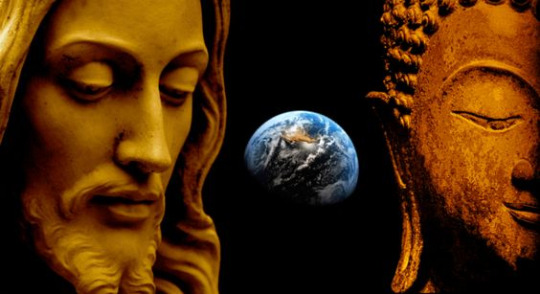#purity culture and Greek myths DO NOT MIX
Text
The Variations of Violence
youtube
Childish Gambino created waves this week with the release of his music video for his latest song “This is America”. Depicting a startling mix of both dance and gun violence, Childish Gambino has managed to raise the question of the values of both the American public and the American media. Although much of the symbolism behind the music video remains unclear and unconfirmed by Gambino himself, the overarching message that has been taken away is one that emphasizes the way the American public prefers to focus on pop culture rather than the violence affecting the population—particularly in black communities. This is shown by Gambino and several others dressed in school uniforms dancing while differing acts of violence appear to be occurring in the background, like individuals fighting and chasing one another.

This is even more drastically contrasted with Gambino pausing his dancing both to shoot one individual and then a group of individuals within a choir, showcasing the brief attention gun violence gets within popular culture before it is distracted with more fleeting events. Gambino here seems to be targeting his audience’s emotions, through contrasting feels of happiness and shock/horror. This is his way of emphasizing the way we would prefer to look at society instead of the way it actually is. Doreen St. Félix of the New Yorker writes about the video “This is what it’s like, Glover’s video seems to say, to be black in America—at any given time, vulnerable to joy or to destruction. When his character is not dancing, he is killing.”

Those on social media have been quick to point out other references as well, including what they believe is a reference to Jim Crow and the biblical four horsemen. Justin Simien, the creator of the popular Netflix original show Dear White People, explained on Twitter,

Other conclusions are continuing to be made, both through popular Twitter threads like Simien’s, and YouTube videos from Gambino fans and music critics. Though the exact meaning of the music video may never be explained, it seems Gambino achieved what he set out to do. Make his audience as well as the general public question what we place our value and attention on in today’s tumultuous society.
youtube
Popular boyband BTS has released a track this week as well as a teaser towards their upcoming album dropping May 18. Member Taehyung or V (as he’s known publicly) is solo in this R&B track “Singularity” as he sings about the danger of losing one’s self within one’s self. Featuring lyrics like “I dumped myself into the lake/I buried my voice for you”, Taehyung seems to be targeting the popular Greek myth of Narcissus—a man cursed to love himself to the extent that he drowns in a lake staring at his own reflection. This can be seen in aspects of the music video as well, particularly a seen shot from below where he seems to be staring at his own reflection and caressing the water.

While the meaning of the song has also not been revealed by the band or anyone within the production, it seems that one can garner this song is about grappling with the idea of loneliness to the extent that someone feels as if they are lost within themselves. The music video features a recurring theme of masks; one’s Taehyung continues to banish as they appear behind him like ghosts in the black surroundings.

Different versions of himself all seemingly being capable of being donned at a moment’s notice. Twitter user @mochiswings seems to feel similarly, as they write about their own interpretation of the song and video and how Taehyung uses the masks to hide or change his true self.

The song and music video’s grappling with loneliness and forced identity is left with a contrasting image in the conclusion of the music video. While the song ends with the chorus “But in the end, spring will come someday/The ice will melt and flow away “ (a reference to the band’s earlier release “Spring Day” about the end of hard times), the music video ends with the donning of one of the white masks with a black tear dripping down the face. Creating a seeming contrast between an inevitable better future, but a future that maintains being forced within one of the masks or identities. A way of possibly saying that one’s self can never truly bypass loneliness without first comprising some part of who they are.

The final release of the week I’ll be covering is the collaboration between Shawn Mendes and Khalid, two of the most notable young performers right now.
youtube
A guitar-led, slow track about the conception of youth in a time that seems to be targeting the young. Featuring the repetitive phrase “You can't take my youth away/This soul of mine will never break”, Khalid and Shawn Mendes reflect about the current time period and the way they are refusing to let the tragedies rob them of their youth. When asked about the song Shawn Mendes said below in interview with Zane Lowe “My youth, trying to be taken away from me. That, not youth as in my age, youth as in my love, my happiness, my joy, my purity.”

Written in the wake of tragedies like the Manchester bombing and the Parkland shooting, Khalid and Mendes target the emotions an event like that can have on an individual and how they feel as if they cannot cope with the outside world. They sing “It's hard to sleep at night, knowing what's outside/Feeling hopeless, I need focus” as a way of describing their own experience following tragic events in the hope of relating with the way their audience may feel as well. They want to express to their audience that these feelings are valid and important, but not all encompassing.

This is made clear later with the lyrics start to demonstrate the way in which these events will not permanently take away themselves or their youth. Singing together “Pain, but I won't let it turn into hate/No, I won't let it change me”, they express that you cannot let the tragedies of today permanently affect you into the future. You must work to get past them in order to maintain your youth, and all the positives that accompany it. Shawn Mendes perhaps explains best in an interview with the Britain’s Daily Star when he says
“It’s the most important song on the album. I was touring around Europe when the events of Manchester and London happened, it was very overwhelming. I wanted to write something but it had to be about the feeling for us as a generation when one of these things happens. So I wrote a song about our youth, a feeling that can’t be taken away from us.
#shawn mendes#khalid#bts#kpop#gun reform#singularity#this is america#childish gambino#youth#social justice#sentientsongs
1 note
·
View note
Text
Was Jesus based on Buddha? Um, NO, and here is why: Debunking Ahead

Siddhartha Gautama, aka Buddha, was a holy man who hailed from ancient India. Rejecting Hinduism and his royal upbringing, Buddha went on to found a new religion, which originally was void of gods (save for an unnamed “Supreme Power” (which isn’t worshipped in Buddhism). However, Buddhism acquired many gods after his death). He taught people how to achieve “Enlightenment”, converting and evangelizing until his death.
Many Jesus Mythicists believe that Jesus was a mythical figure based on Buddha, that the latter’s stories were the framework for that of Christ.
Is this the case?
Nope.
Let’s see why:
OF GOSPELS AND NOBLE TRUTHS

Like Jesus Christ, Buddha was a historical figure. However, the exact time period in which he lived is up for grabs (he may have been born in the 7th, 6th or 5th century BC, we don’t know for sure, though the scholarly consensus places it in the latter). One reason why this is the case is because Buddha’s teachings and biographies were written down centuries after he died. Indeed, Buddha’s teaching were passed on orally until the first century AD, when it was written down, becoming the Pali Canon (aka Tripitaka). The latest possible date of Buddha’s death is sometime between 410-370 BC, so we are talking about a long time between the historical Buddha and his earliest biographies and written scriptures. That is a LOT of time for legends and myths to be added into the Buddha’s historical account, and sure enough scholars agree that this indeed was the case. Other Buddhist scriptures abound, but these two are late (“Questions of King Milinda”, 1rst century AD. “The Way to Purity”, 5th century AD. “The Summary of the Meaning of Higher Teaching”, 11th century AD). Buddha’s first Biography, the “Buddhacarita”, was written in the second century AD.
Now, compare the dates for these Buddhist texts again:
Tripitaka: 1rst century AD
“Questions of King Milinda”, 1rst century AD
“Buddhacarita”, 2nd century AD
“The Way to Purity”, 5th century AD
“The Summary of the Meaning of Higher Teaching”, 11th Century AD.
Why is this significant?
Jesus died in 30-33 AD.

The Gospels were also originally in oral form, but where turned into written accounts only a few decades after Christ. They were written in the 1rst century (earliest Mark (60-70 AD), the latest John (70-90’s AD).
And remember: The gospels were not just a collection of Christ’s teachings; they were also biographies.
Buddha’s first biography? 2nd century AD.
Who is borrowing from who?

Now, to be fair, Buddhists may have come up with similar ideas on their own (Mean old Mr Coincidence at it again).
Also, to be fair, there is a third century inscription about Buddha that has a bearing on this subject, but as we are about to see, it does not support the idea that Jesus was based on Buddha.
Indeed, much of the so-called similarities between Jesus and Buddha are downright daft, when you look more closely.
1. Virgin Born?
Later accounts of the Buddha seem to indicate that he had a sexless birth. However, one has to remember that Buddha’s Mom, Maya, was married to King Suddhodana at the time of Buddha’s conception. Indeed, she had been so for years, so we can’t really claim that she was a virgin (what do husbands do with their wives now and again? Give you a hint: involves a bed, getting naked and moans!). Indeed, the “virgin” idea was a later invention, not part of the original story of Buddha. According to the tale, on the night that Buddha was conceived, Buddha’s spirit appeared to Maya in a dream. He had the form of a white elephant floating on a rain cloud. He circled the queen three times and then went inside her womb. Though this story dates in Buddhist Literature to the 5th century AD, there is inscriptional evidence from the 3rd century BC that seems (repeat “seems”) to depict this account.
However…the earliest account of this story only indicates that this was a dream, a sign that Maya was pregnant with the Buddha. Later Buddhist sources made this event more literal, that Maya didn’t conceive Buddha through sex. But this was a later tradition, and it postdates Christ considerably. Indeed, numerous sources state that King Suddhodana was indeed his father, i.e. biological father.
Either way you look at it…no virgin birth.
2. Maya and Mary sound similar? Mary is based on Maya?
Mary was a Roman era peasant girl. Though she descended from King David, she was no royal. Maya was an Indian Queen. Also, the name Mary isn’t based on Maya; it’s the Greek form of the Hebrew word “Miryam”!
3. Wise men?

Buddha’s father was a king. It paid to have wise men working for you, as most rulers did, big deal. Its not like they had to travel far to see the newborn buddha (Buddha and these “wise men” were in the same palace!). Plus, they don’t offer Buddha gifts of gold, frankincense and myrrh.
Next?
4. Incarnate god?
Though some Buddhists worship him as a god, Buddha is not considered a god in mainstream Buddhism. Indeed, he is considered the greatest holy man. Before he became such, Buddha was thought to have been a Bodhisattvas or “Enlightenment Being”. Bodhisattvas are future Buddhas, reincarnating again and again as humans until they became buddhas (regular humans were likewise thought to reincarnate). Some fulfill a similar role to angels in the Bible, and like them are very powerful. Nevertheless, they are not considered gods, and neither is Buddha. In Hinduism, Buddha is said to be one of the Avatars of the Hindu god Vishnu, but this was not what Buddha himself taught. Indeed, when Jesus Mythicists try to claim that he was an incarnate god, they mix Hindu theology with Buddhist theology, all the while claiming that their amalgamized version of Buddha is what Buddhists believe in!
Oh, by the way: Buddha was first identified as an Avatar of Vishnu in the third of fourth century...AD!

5. A king sought to kill him after he was born?
Nope.
6. Taught religious leaders as a 12 year old?
No, he was said to be a very quick learner. When he was 12, it was predicted that he would become an ascetic if he saw death, sickness, old age, or a recluse.
7. Baptized?
No.
8. Tempted by a demon?
He was tempted by a demon named Mara, but the temptation has little resemblance to that of Christ.
9. Miracle worker?
So were a lot of religious figures (Moses, Zoaraster, Elijah, Elisha), gods and other supernatural beings. Big deal.

10. Miraculously fed a multitude with a basket of cakes?
No.
11. Crucified?
No, he actually died of food poisoning (courtesy of a meal by a smith named Cunda).
12. Resurrected?
Once again, no. Though he attained “Nirvana”, he didn’t physically resurrect.
Do we really have to go on?
Sources:
https://www.ancient.eu/Siddhartha_Gautama/
“The Ultimate Encyclopedia of Mythology” by Arthur Cotterell, and Rachel Storm, pages 355, 360-61, 368-69, 378-79, 386, 412-415
“Encyclopedia of Gods” by Michael Jordan (Not to be confused with Michael Jordon, the American god of Basketball), page 48
https://www.britannica.com/topic/Tipitaka
https://goldenbuddha.net/buddhist-gods-guide-buddhist-pantheon/
http://www.chinabuddhismencyclopedia.com/en/index.php/Buddhist_Gods_and_Goddesses
“AMG’s Encyclopedia of World Religions, Cults & the Occult”, by Mark Water, pages 214-15, 218-19, 246-47
“The Case for the Real Jesus” by Lee Strobel, pages 181-82, 292
“Historical Atlas: A Comprehensive History of the World” (Chief Consultant Dr Geoffery Wawro), pages 84-85, 106-07
https://www.youtube.com/watch?v=_rulpyz1VOQ&feature=emb_title
https://www.khanacademy.org/humanities/art-asia/beginners-guide-asian-culture/buddhist-art-culture/a/bodhisattva-maitreya
“Norris McWhirter’s Book of Historical Records” by Norris McWhirter, page 42
0 notes